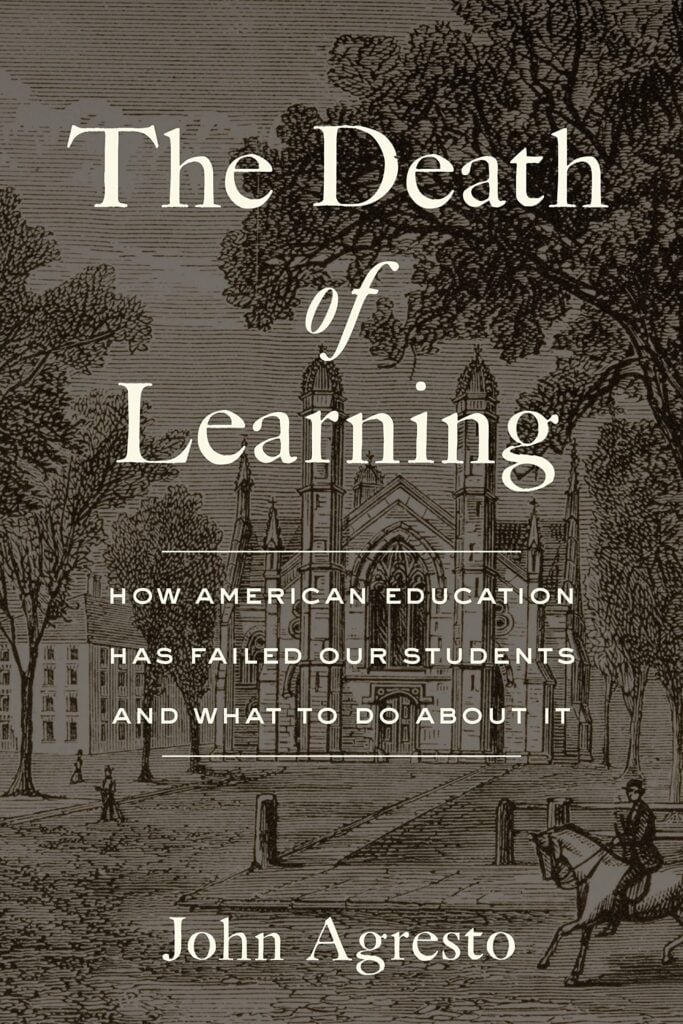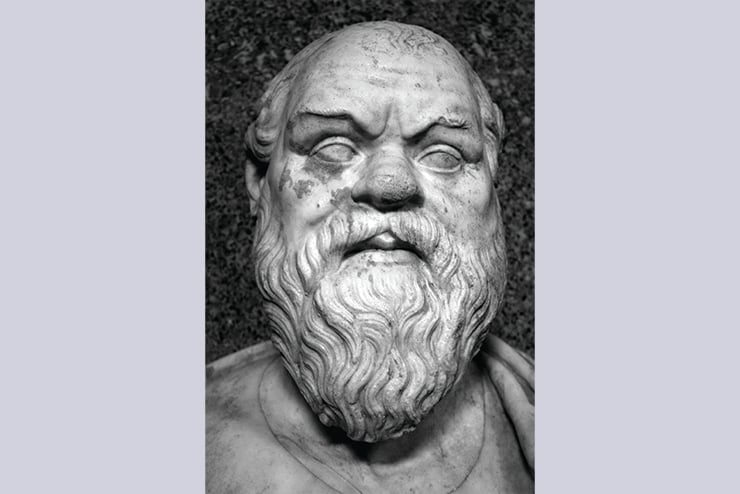A fence-sitting attempt to reform higher education by a disciple of Allan Bloom falls flat

The Death of Learning: How American Education Has Failed Our Students and What to Do About It
by John Agresto
Encounter Books
272 pp., $30.99
A glaring fault plagues the multitude of recent books bemoaning higher education’s dismal state. However effectively some diagnose the problem, they each stop before criticizing the existing system and, sadly, offer few solutions. Luckily John Agresto, a disciple of Allan Bloom, avoids this common pitfall. He is full of ideas about what needs to be done to fix the broken liberal arts tradition. Unfortunately, his proposed plan won’t work, which speaks to both the severity of the problem and the limits of his vision.
A liberal arts education, in Agresto’s account, should “free minds” rather than “capture them.” Setting up the opposition thusly makes it easier to sympathize with his stance. But what are we freeing minds for? And from what? Agresto’s view sounds suspiciously similar to the old antiestablishment adage “Question Everything.” Yet the very models on which he would build his ideal liberal arts college present no such position.
Agresto, an academic, former president of St. John’s College, and a Reagan-era political appointee to the National Endowment for the Humanities, refers often to the classical Greeks as a prototype of the “Question Everything” method, and Socrates as a prime example among them. But here he strays. According to Xenophon’s Apology, Socrates denied the accusation made at his trial that he had rejected the gods of the state. He affirmed that he had sacrificed at public altars and attended religious festivals. More importantly, he faithfully served his homeland with distinction in the Athenian army during the Peloponnesian Wars. In the Symposium, Plato describes Socrates’ heroic endurance during military campaigns.
Socrates took his responsibilities to his country and its gods as a matter beyond critical examination. These duties were incumbent on him by virtue of his place of birth and his emotional attachment to the land that long nurtured him. Remarkably, this is the same traditional allegiance that Agresto argues liberal arts education should work to dissolve. He approves of his mentor Bloom’s belief that the liberal arts do their students the service of liberating minds from the “tyranny of the Ps…parents, poets, and priests.” In a footnote, Agresto chides traditionalists who championed Bloom’s The Closing of the American Mind, [Read Chronicles Editor Paul Gottfried’s 1987 review] for having overlooked “its radicalism,” a reference to the book’s indifference to the baseline institutional structures that conservatives otherwise champion.
A liberal arts college that sets itself up with such a raison d’être—to have students question all authority, especially that of their parents and their religious and cultural traditions—will only end up exactly where our current institutions are. It wasn’t Socrates’ willingness to apply the acid of criticism indiscriminately to everything that set him apart. It was his intellectual humility. He did not purport to present a view from nowhere, critically reigning in lordly fashion over all entrants to the realm of ideas. He understood his knowledge’s limits and likewise understood that the knowledge process needs a strong epistemological foundation.
Having thus attacked traditionalists in the name of free minds, it seems odd for Agresto in the same book to lay down a steady barrage against the pedagogical malpractice of “critical thinking.” The celebration of uninformed criticism of the past, he writes, is little but cover for the professoriate’s will to trash every thinker who preceded our woke era as hopelessly benighted. While a proper, measured, and critical reconsideration of existing knowledge should be undertaken, Agresto argues for an initial attitude of “wonder” toward the traditional liberal arts canon.
This admirable perspective will be a high bar for today’s blasé students. A more approachable goal might be to demand that students see understanding as their primary task. This would help them avoid wasting time wallowing in their innate progressive prejudices against canonical texts and their authors.
The back-and-forth nature of Agresto’s critique reveals his desire to straddle an imaginary nonpartisan fence. He directs the same withering criticism at “dogmatic conservatives and sectarian colleges” that he does at “doctrinaire … left-leaning colleges.” While it is certainly true that the left has expunged many ideas from the curriculum for purely political reasons, Agresto claims right-wingers likewise aim to eliminate the “corrupt morals” of figures like Rousseau, Nietzsche, and Marx.
There may be a few public reactionaries who want to censor the study of immoral philosophers, but I can’t name a single tradition-oriented scholar who holds such a view. Indeed, conservative scholars often spend much of their classroom time teaching leftist authors in order to demonstrate the weakness of their theories. I myself teach a course on the history of conservative political thought in which we spend nearly half the semester covering revolutionary traditions and their thinkers, from the French Revolution through America’s 1960s cultural revolution.
Readers will be similarly surprised to find Agresto expressing confidence that “serious pushback” against woke “authoritarianism” pervades liberal arts schools. He also believes students represent a natural force against its advance because they “know the difference between being taught and being indoctrinated.” But he provides no evidence for these assertions.
I have seen little resistance to the establishment of the Diversity/Inclusion/Equity apparatus in every corner of my school. Most students I encounter do not know the difference between teaching and indoctrination. No insult to them; they are young and inexperienced. Moreover, they inhabit a culture in which powerful elites present one set of ideas as the only morally defensible ones. What innate defense mechanisms could we imagine them gifted with that provide immunity against such monolithic cultural and institutional pressures?
In his favor, Agresto properly disapproves of the idea that liberal arts education should be about encouraging student research. Nowadays, nearly every school trumpets this platitude to prospective undergraduates as self-evidently superior to the idea of students as humble and grateful recipients of a venerable intellectual tradition. The move toward undergraduate research has produced reams of senior theses. Alas, these amateurish texts contribute next to nothing to accumulated knowledge. Colleges are increasingly unapologetic about defining themselves as consumer product providers answerable only to buyers’ demands. They cynically applaud the rising mountain of almost entirely worthless undergraduate research while avariciously tallying up their tuition dollar profits.
Agresto also admirably deemphasizes the undergraduate major. Instead, he argues students should receive a broader introduction to a wide array of intellectual themes and questions. But how amenable will today’s students be to such a radical shift? Much like his mentor, Bloom, Agresto imagines his students as intellectuals-in-training. The student populations in a few—very few—select schools skew more in this direction than at their far more numerous, less select peers. But the average college student today will not submit himself to such a regime. Nor will he flourish in it if it is imposed upon him. It is more than fantasy to imagine the average college student today as one of the young aristocrats following Socrates around in Athens two and half millennia ago.
Agresto believes a liberal arts education should expose students to a wide range of ideas and then let them pick and choose among them. But on what basis and under what influences will unwitting students choose? Given the ideological makeup of today’s university faculties and their incessant in-your-face advocacy of their pet causes, this will put radical thought at a distinct advantage. Likewise, the diversity of ideas in the contemporary liberal arts curriculum is greater than Agresto has bothered to notice. Marx and Rousseau, whom Agresto sees as the liberal arts’ anti-traditionalists par excellence, are an accepted, yet misbegotten, part of that tradition. But they become de facto traditionalists compared to a good deal of the newly minted lunacy assigned to college students today.
Women’s studies courses routinely advocate for the bizarre idea that sex differences themselves are pure fiction. What biologists know as our species’ empirical truth the contemporary academic radical sees as an invention cut out of whole cloth by partisan patriarchs to propagate political and misogynistic falsehoods. Countless other equally farcical ideas have of late taken root in our rootless institutions of higher education. There will be no way to rule that now-entrenched politicized material out of bounds for Agresto’s reformed curriculum as it is supported by substantial percentages of the faculties.
Unfortunately, if we can’t eliminate these absurdities, the time students have to dedicate themselves to debates that constitute the traditional spirit of a liberal arts education will be substantially restricted. After all, students will also be required to spend significant time memorizing and reciting the creed of opposition to intellectual phantoms like the invisible, malevolent omnipresence of anti-blackness and structural racism. Equal time for Judith Butler, Ibram X. Kendi, Marx, and Plato is a “solution” that will inevitably bring an end to the American liberal arts tradition.



Leave a Reply